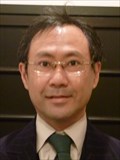
Japan Study Special Award
Rhee Kenji (Professor of Sociology at Kwansei Gakuin University)
“Rishi Chosen Saigo no Ou Rigin: Dai Ikkan, Daikan Teikoku 1897-1907,Dai Nikan ,Dainihon Teikoku (Meijiki)1907-1912” - English translation:[The Last King of the Lee Dynasty Lee Eun: the first volume Korean Empire 1897-1907,the second volume the Empire of Japan (Meiji period) 1907-1912](Sakuhinsha,2019)
Recipient’s remarks

I am deeply honored to receive the Japan Study Special Award for my book, “Ri-shi Chosen Saigo no Ou - Ri Gin (Vols. 1-2).” Lee Eun - Ri Gin in Japanese - is fairly well known in Japan as the last crown prince of the Empire of Korea, who, as a Korean royal family member, married Princess Masako of the Nashimoto branch of the Japanese Imperial family. But his life, which was full of hardships, has been illustrated in Japan often just in connection with his relationship with Princess Masako.
Of course, references to his life have not always been sketchy. For instance, Mr. Michihiko Shinjo wrote “Tenno no Kankoku Heigo” (The Emperor’s Annexation of Korea) (Hosei University Press, 2008), explaining in detail how Korean royal family members were treated in the wake of the annexation. Novelist Jang Hyuk-joo published “Ri O ke Hishi — Hien no Hana” (The Tragedy of the Lee Dynasty - The Flower of the Secret Garden)(Sekaisha, 1950), a novel based on a series of interviews with Lee Eun. Korean author Song U-hye extensively covered the life of Lee Eun in a four-volume book, “Saigono Kotaishi”(The Last Prince)(Puleun-yeogsa, 2010-2012).
However, I, for my part, was more curious to know what kinds of rites of passage he went through and what kinds of people he interacted with. As a cultural researcher, I really wanted to find out archival records that might show the humane side of his life. As I combed through daily records concerning him, including “Gosancho Nikki” (Daily Records of the Hosancheon Delivery Room Office) and “Eishinoufu Nikki” (The Diary of Imperial Prince Yeong), I was able to learn various episodes related to him. When I read “Taisho Tenno Jitsuroku” (Emperor Taisho’s annals), it became clear to me that Lee Eun and the Japanese monarch fostered a really close friendship between them. Though he truly lived quietly, there were many surprises and discoveries in those records. Diaries are amazing enough because even though they monotonously record what happen in someone’s life as each boresome day goes by, you can discern the inner workings and behind-the-scene circumstances, such as political backgrounds, as you repeatedly read them. For example, there were diary entries about Korean Emperor Gojong’s choice to pretend to be sick as he wanted to avoid Hirobumi Ito - at the time, the Korean monarch was plotting the Hague Secret Emissary Affair of 1907. Novelists present dramatic scenes in their books, but mine has no such scenes. Instead, it sheds light on the aspects of “politics” and “international relations” shown or implied monotonously in the related diaries. It also depicts how queens and palace officials of the Lee dynasty behaved - in the book, I illustrated them as if they were appearing in emaki picture scrolls. To my own surprise, I became amazingly particular about emaki-style narratives.
The Kokkiken award makes me reaffirm the significance of completing the remaining two volumes of this critical biography of Lee Eun. I am also determined anew to keep growing as a cultural researcher with further encouragement from really serious readers. I would like to give my special thanks to Mr. Sukehiro Hirakawa and Mr. Toshio Watanabe, both of whom intensely read my book, Mr. Shinji Nobuhiro, who was my supervising professor, and, in particular, Mr. Toru Haga who is now in heaven.
Recipient’s biography
Rhee Kenji was born in Koyama, Shinagawa-ku, Tokyo, in March 1969. He graduated from Tokyo Metropolitan Hibiya High School in 1987 and the Department of Philosophy of the Faculty of Letters at Chuo University in 1992. He finished a master’s program in comparative culture at the Graduate School of Arts and Sciences of the University of Tokyo in 1994. In February and March 2000, he completed a doctoral program in Korean language and literature at the Graduate School of Yonsei University in South Korea and a doctoral program in interdisciplinary cultural studies at the Graduate School of the University of Tokyo. In April 2000, he became a lecturer at the then Department of Humanities and Social Sciences of Kyoto Notre Dame University. In 2003, he became an assistant professor at the Department of International Culture of then Hiroshima Women’s College (now Prefectural University of Hiroshima), where he became an associate professor in 2007. Since September 2010, he has been a professor at the School of Sociology of Kwansei Gakuin University.
He has authored a number of books, including “Chosen Kindai Bungaku to Nashonarizumu — ‘Teiko no Nashonarizumu’ Hihan” (Modern Korean Literature and Nationalism — Criticism of ‘Nationalism of Resistance’)(Sakuhinsha, 2007); “Nikkan Nashonarizumu no Kaitai — ‘Fukusu no Identity wo Ikiru Shiso” (Breaking with Japanese-South Korean Nationalism — A Thought to Live with Multiple Identities)(Chikumashobo, 2008); “Matsuda Yusaku to Shichinin no Sakka-tachi — ‘Tantei Monogatari’ no Misuteri” (Yusaku Matsuda and Seven Authors — Mystery of ‘Detective Story’)(Genshobo, 2011). He worked together with his wife Yuki Saito to compile a book, “Kyoto no Machiya wo Saiseisuru — Iezukuri kara Miete kita Nihon no Bunkahakai to Bunkakeisho” (Reviving Machiya Wooden Townhouses in Kyoto — A Scene of Destruction and Succession of Culture As Seen from House Building Efforts)(Kwansei Gakuin University Press, 2015).
Rhee currently lives with his wife in a 100-year-old machiya townhouse in an area, known for kimono, in the city of Kyoto.
Japan Study Encouragement Award
Minggad Bulag (Writer, Translator, Interpreter)
Kusahara ni Homurareta Kioku “Nihon Tokumu” - Nihonjin ni yoru “Uchi Mongoru Kosaku” to Mongorujin ni yoru “Tainichi Kyoryoku” no Hikari to Kage - English translation:[ Japan’s” Tokumu” Special Duty Organs: The Past That was Buried in Steppe: The Bright and Dark Sides of ‘Espionage and Undercover Operations in Inner Mongolia’ by Japanese and ‘Cooperation with Japan’ by Mongolians] (Kwansei Gakuin University Press, 2019)
Recipient’s remark

It is a great honor to receive a Japan Study Encouragement Award from the Japan Institute for National Fundamentals. I would like to extend my heartfelt gratitude to the Award Jury members for appreciating my book. I would also like to thank Kwansei Gakuin University Press for publishing my book and Prof. Yang Haiying of Shizuoka University for writing a compelling promotional phrase on the book’s obi strip. Further, I am grateful to all of those who have continuously supported me and to my family for their love and support.
I am from the Inner Mongolia Autonomous Region of China, an area popularly known as “Inner Mongolia” and often referred to as “South Mongolia.” During the era of Manchukuo, the eastern side of what is now Inner Mongolia was incorporated into Manchukuo. At the time, the western side of Inner Mongolia was effectively regarded as a “second Manchukuo.” Mr. Kaiun Mishima, the founder of the Calpis brand, visited Inner Mongolia in around the 40th year of the Meiji era or 1907 and found people of the steppe drinking a traditional cultured milk product. Taking a clue from it, he invented the lactic acid beverage named Calpis. Likewise, Inner Mongolia is the scene of “Suho no Shiroi Uma” (Suho’s White Horse), the tragic tale well known in Japan in connection with the origin of the Mongolian folk instrument of morin khuur (horsehead fiddle).
As such, modern Japan was involved in Inner Mongolia for a long period of time. One of my granduncles is now 96 years old - he is still reading Japanese philosophy books every day with a magnifying glass in hand, Many Japanese may be surprised to hear this, but he is truly doing so. During the era of Manchukuo, my granduncle was taught Japanese in the grassland of the western side of Inner Mongolia, the second Manchukuo. As he learned all subjects in Japanese when he was a junior and senior school student, he speaks Japanese fluently even today. It is my understanding that the fact that my granduncle retains a high level of Japanese language proficiency demonstrates how deeply connected Inner Mongolia and Japan have been to each other.
Nonetheless, despite the historical weight of Japan’s involvement in Inner Mongolia, it is a great pity, from the standpoint of the Inner Mongolians, many things have been forgotten. For this reason, I dared to choose to pursue this theme in my research. I am very pleased that my research has been evaluated. My book is an anecdotal history book focusing on Mongolia that was at the mercy of Japan, the Soviet Union and China. Of the three big powers, Japan undoubtedly took the lead. We Inner Mongolians understand that our anecdotal history that goes back to the time when Japan was directly or indirectly involved in Inner Mongolia is a definite part of Japan’s modern history. Therefore, I hope from the bottom of my heart that as many Japanese as possible will become aware of this history.
The award encourages me to push forward with my research. I hope that all of you will continue to support me.
Recipient’s biography
Bulag Minggad, born in Xilingol pasture of the Inner Mongolia Autonomous Region in 1974, spent his early life in the traditional Mongolian nomadic culture.
In 1995, he graduated from a four-year normal school (teachers college) in Xilingol, becoming a schoolteacher. In 2011, he completed the doctoral program at Kwansei Gakuin University’s Graduate School of Education, obtaining a doctorate in education. After working, among others, as a part-time instructor at Kwansei Gakuin University’s School of Education, he now free-lances as a writer, translator/interpreter and horsehead fiddle player going to various parts of Japan. In addition, he serves a free-lance lecturer mainly in the Kansai region to facilitate international understanding and multi-cultural coexistence, deal with problems related to children of foreign nationalities and teach his mother tongue.
While specializing in education, he assiduously pursues themes in other fields, such as cultural anthropology, ethnic music, music therapy and modern Mongolian history, from the standpoint of comparative anthropological studies in education. He thinks that he, as an educator, needs to know as much as possible about those fields.
He has received a number of awards, including the Kwansei Gakuin University Alumni Association’s meritorious achievement award in 2006; the sixth Masatsugu Murakami Award from the Nippon Mongol Association in 2013 for his 2013 essay in the “Nippon to Mongoru” organ of the association (Vo. 126) titled “Is ‘Suho’s White Horse’ a real Mongolian folklore?” ; and the 41st Japan Society for Children’s Literature Encouragement Award in 2017 for his 2016 book, “’Suho no Shiroi Uma’ no Shinjitsu — Mongoru, Chugoku, Nippon Sorezore no Sugata” (The Truth of “Suho’s White Horse” — the Postures of Mongolia, China and Japan), published in 2016 by Fukyosha Publishing Inc. He has written many books and essays.

